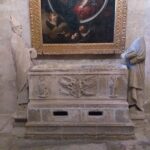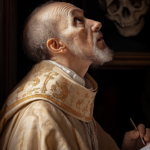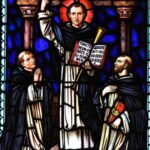St. Wolfgang
Saint Wolfgang
When They Lived:
St. Wolfgang was born around the year 934 and passed away in 994. He lived during the tumultuous transition period between the Early and High Middle Ages, a time characterized by great changes in Europe.
Where They Lived:
St. Wolfgang’s life unfolded primarily in the heart of Europe, within the region that is now modern-day Austria. His most significant contributions occurred in the eastern parts of the Holy Roman Empire, which included areas such as Bavaria and the Salzkammergut region, nestled amidst the breathtaking Austrian Alps.
Notable World Events During the Time of Their Life:
- Viking Raids (Late 9th – Early 11th Century): St. Wolfgang lived in an age when Viking raids were widespread across Europe. These fearsome Norse warriors terrorized coastal regions and navigated inland waterways, leaving a significant impact on the political and social landscapes of the time.
- Magyar Invasions (9th-10th Century): The Magyars, a nomadic people from the east, launched invasions into Europe during St. Wolfgang’s lifetime. These invasions played a crucial role in shaping the geopolitical boundaries of Europe.
- Ottonian Renaissance (10th Century): St. Wolfgang’s life coincided with the Ottonian Renaissance, a cultural revival fostered by the Holy Roman Emperors of the Ottonian dynasty. This period witnessed the promotion of arts, architecture, and education, contributing to the preservation and transmission of knowledge.
- Foundation of the Holy Roman Empire (962 AD): In 962 AD, Pope John XII crowned Otto I as the Holy Roman Emperor. This event marked the beginning of the Holy Roman Empire, which would dominate Central Europe for centuries and greatly influence St. Wolfgang’s life.
- Scientific Advancements: Although not directly related to St. Wolfgang, the 10th century saw advancements in fields like astronomy, mathematics, and medicine in the Islamic world, laying the groundwork for future scientific developments in Europe.
- Rise of Monasticism: During St. Wolfgang’s time, monasticism and the founding of monastic orders played a pivotal role in both religious and intellectual life. This environment likely influenced his own spiritual journey.
Their Patronage:
St. Wolfgang is revered as the patron saint of many causes, making him a figure of great significance to a wide range of individuals:
- Patron of Sailors and Mariners: St. Wolfgang’s association with water, particularly through the miracle of taming the Wolfgangsee lake, led to his patronage of sailors and those who navigate the seas.
- Patron of Spouses and Expectant Mothers: St. Wolfgang’s compassionate nature extends to families, as he is often invoked to protect spouses and expectant mothers during childbirth.
- Patron of Loggers and Woodworkers: His connection to the dense Alpine forests in Austria has made him a patron for those involved in logging and woodworking.
- Patron Against Paralysis and Strokes: St. Wolfgang’s intercession is sought by those afflicted with paralysis and strokes, reflecting his miraculous healing abilities.
St. Wolfgang’s life, set against the backdrop of an ever-changing Europe, demonstrates the interplay of faith, nature, and human progress in a pivotal period of history. His multifaceted patronage continues to inspire and protect people from diverse walks of life.
Early Life
Saint Wolfgang of Regensburg was born around 934 A.D. He was said to have come from a family in historic Southwestern Germany. He was noble, as his family was said to be from a line of Swabian counts.
He was home-schooled by the clergy until the age of 7. He then decided he wanted to wander down the path of spirituality. He chose to attend the popular monastic institution at Reichenau Abbey.
At the monastery, he became friends with Henry of Babenberg, whose brother was Bishop Poppo. After their friendship kicked off, Saint Wolfgang followed Henry to Würzburg.
At Würzburg, Henry and Wolfgang attended a cathedral educational institution where they were tutored by a great man called Stephen of Novara.
They went their separate ways for a while. Years later, around 956, Henry was appointed Archbishop of Trier. He then invited Wolfgang to lecture at the Cathedral School of Trier.
While acting as a tutor, Saint Wolfgang continued to work to improve the archdiocese. While in Trier, Saint Wolfgang joined Saint Maximin’s Abbey. There he met Saint Romuald.
While in the monastery, Saint Wolfgang was deeply influenced by the great men he met. He began to exhibit an interest in the ascetic lifestyle.
After his friend, Archbishop Henry, passed away circa 964, Saint Wolfgang joined the Benedictine order in Switzerland. In 968, at the Abbey of Maria Einsiedeln, he was appointed priest by Saint Ulrich.
Dedication and devotion
During that time, war broke out between the Hungarians and Lechfeld. The Hungarians lost and decided to live in Pannonia.
However, the Hungarians, who were pagans, decided not to convert to Christianity.
Worried that they might make trouble for his people, Emperor Otto the Great and Saint Ulrich were sent to minister to the Hungarians.
Wolfgang succeeded Michael of Regensburg as Bishop around late 972. Saint Wolfgang ruled the diocese with peace and education.
Even as a bishop, Saint Wolfgang was said to have taught Emperor Henry II. Some traditions have it that Wolfgang taught Henry everything he needed to know about his spiritual life.
Wolfgang was a man of discipline. He was said to have established more abbots for Saint Emeram’s Abbey. He was also said to have renovated abbeys in Obermünster and Niedermünster.
Legacy
Saint Wolfgang was also instrumental in the renovation of the old Benedictine abbey at Niederalttaich. He breathed new life into the ancient monastery, causing it to once again be recognized for its beauty.
Saot Wolfgang was also very generous. When the Diocese of Prague was established in 975, it lacked members. This caused Emperor Otto II to plead with Wolfgang to cut his diocese to about half its size.
Wolfgang agreed and split his membership with Saint Adalbert of Prague. He was so respected that he was always invited to political gatherings.
At an old age, Wolfgang went into seclusion in Upper Austria. Some people claim that this was due to a political problem. Others seem to think he simply got lost.
Regardless of what happened, Saint Wolfgang was said to have been found by a hunter. He then broke back into the city.
Death and Canonization
Saint Wolfgang fell sick while traveling from the Danube to Pöchlarn. Knowing that his end was near, he asked to be carried to Saint Othmarchapel in Pupping.
Saint Wolfgang died on the 31st of October, 994 A.D. He was buried in Saint Emmeram’s Abbey in Germany. Even in death, he was said to have been a bearer of miracles.
Saint Wolfgang was canonized by Pope Leo IX on October 8, 1051. He is celebrated by the Roman Catholic Church on October 31st.
5 Interesting Facts About Saint Wolfgang
- Did you know that Saint Wolfgang is the patron saint of apoplexy?
paralysis, stroke, and carpenters? - Did you know that where Saing Wolfgang went into solitude is now
known as Wolfgangsee or Wolfgang Lake? - Did you know that Saint Wolfgang’s body was taken to Regensburg by
Archbishop Hartwich of Salzburg and Count Aribo of Andechs? - Did you know that a miniature portrait of Saint Wolfgang survived?
from 1100? - Did you know that Saint Wolfgang is often thought to be a part of
the Fourteen Holy Helpers?
Prayer to Saint Wolfgang
Dear Lord, Give us the grace to put on the armor of God, that we may be able to resist on an evil day and, having done everything, to hold our ground. Enable us to stand fast with our loins girded in truth, clothed with righteousness as a breastplate, and our feet shod in readiness for the Gospel of peace. In Jesus’ mighty name, we pray. Amen.
Sources:[https://www.catholicdoors.com/prayers/novenas/p04058.htm]{.ul}



